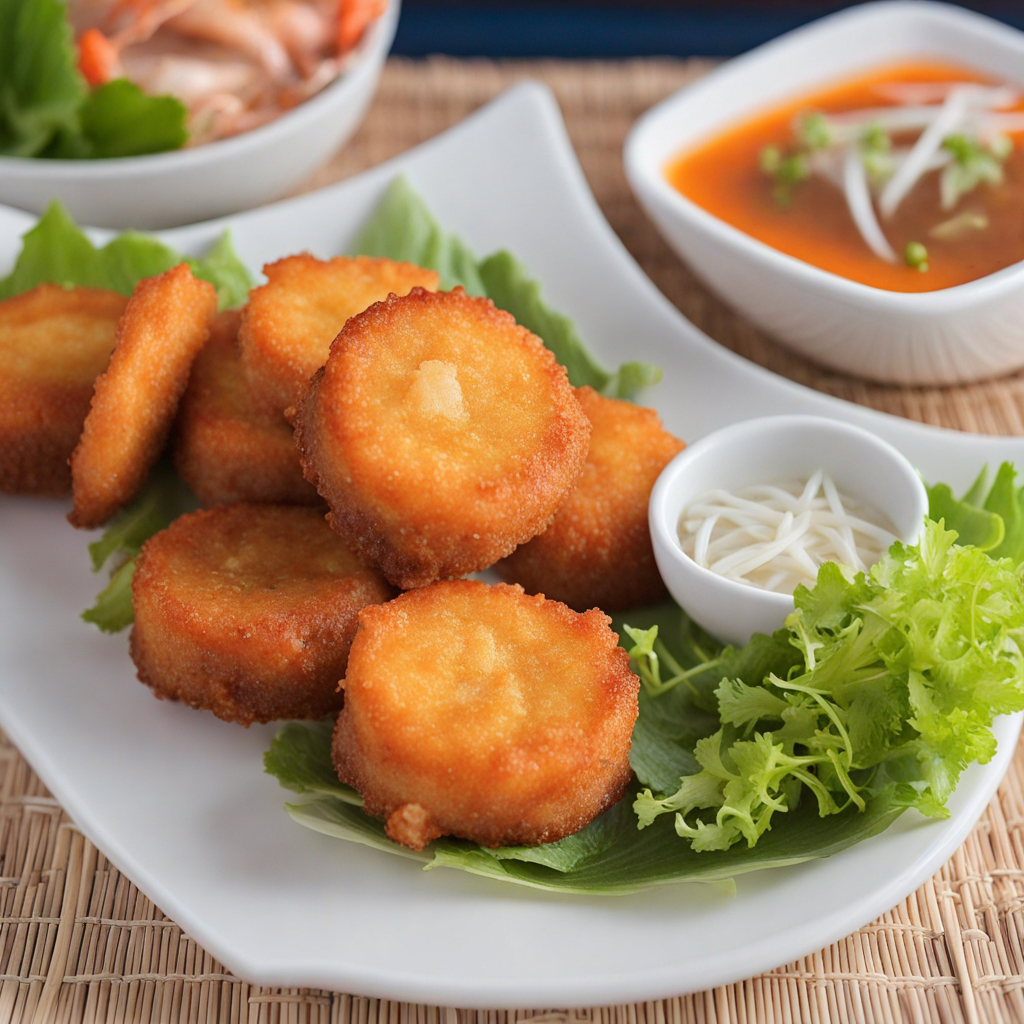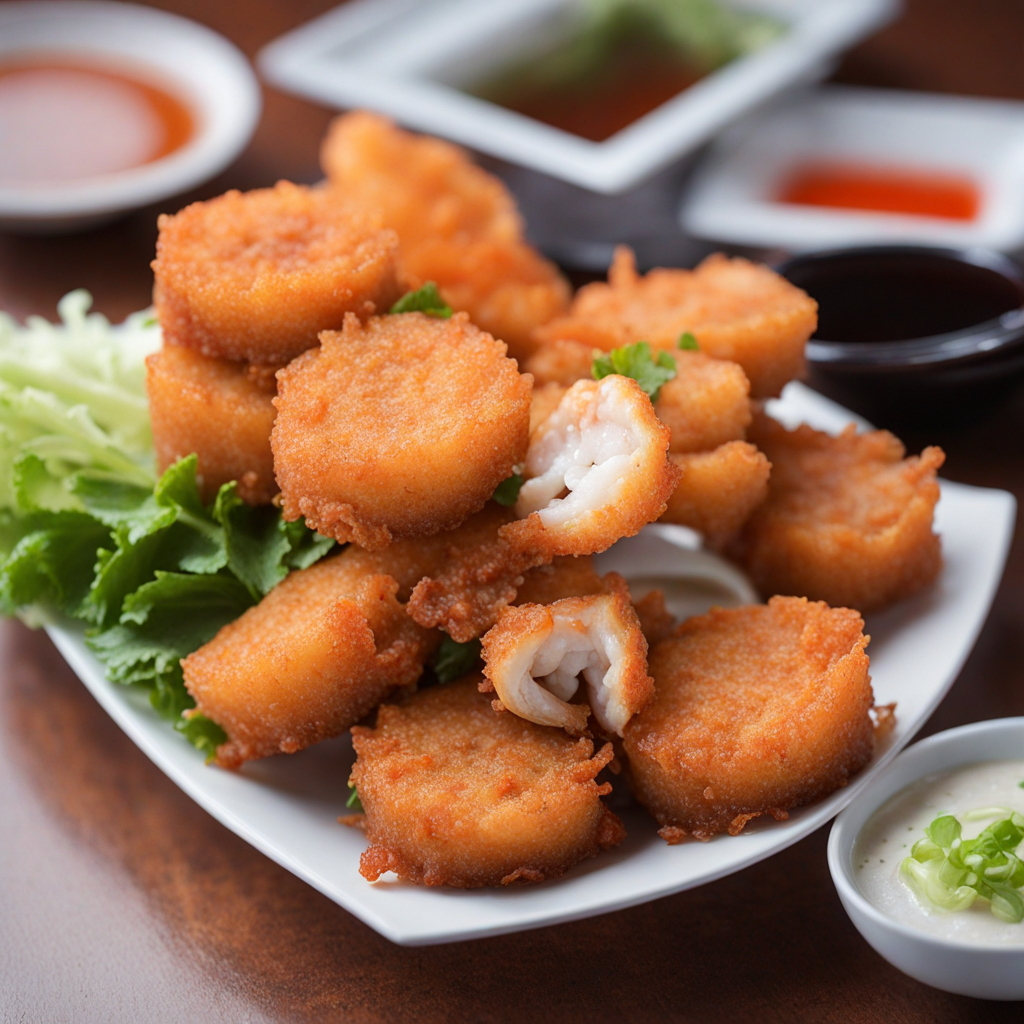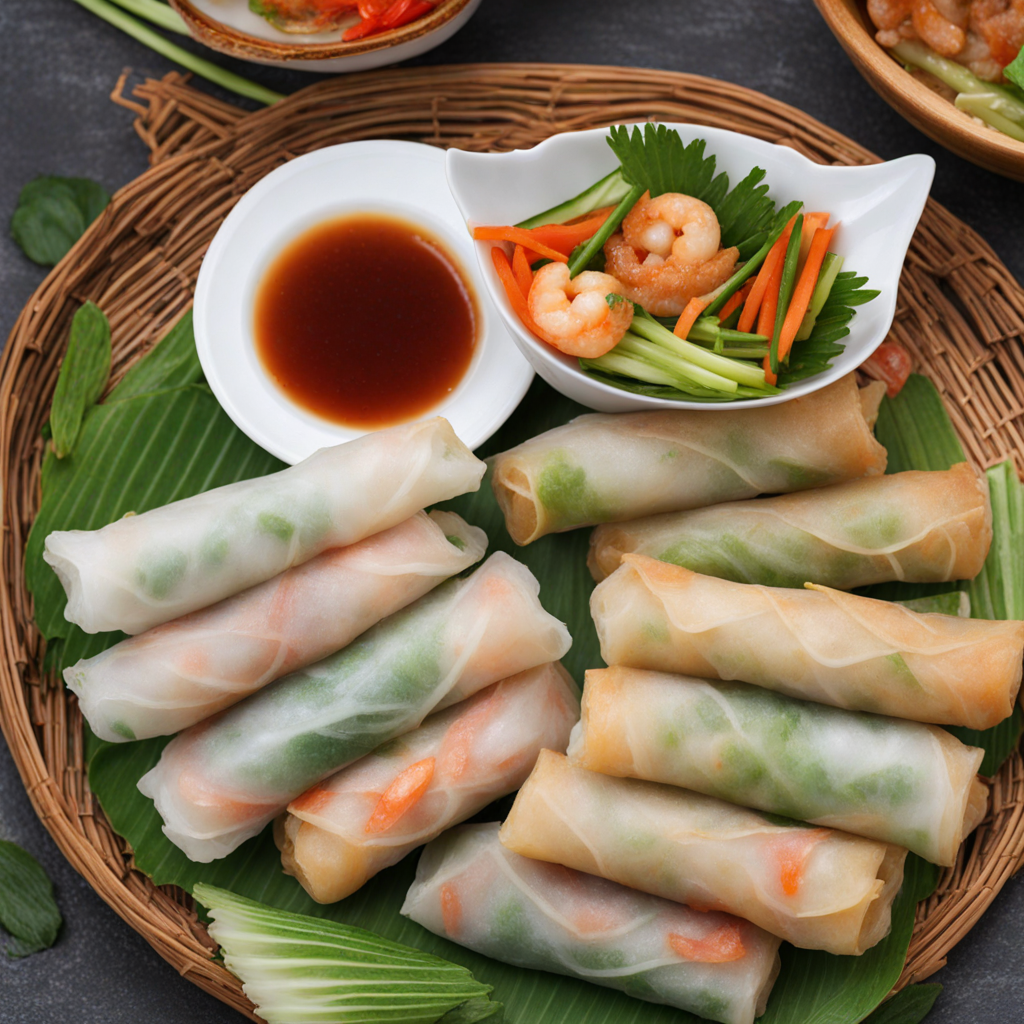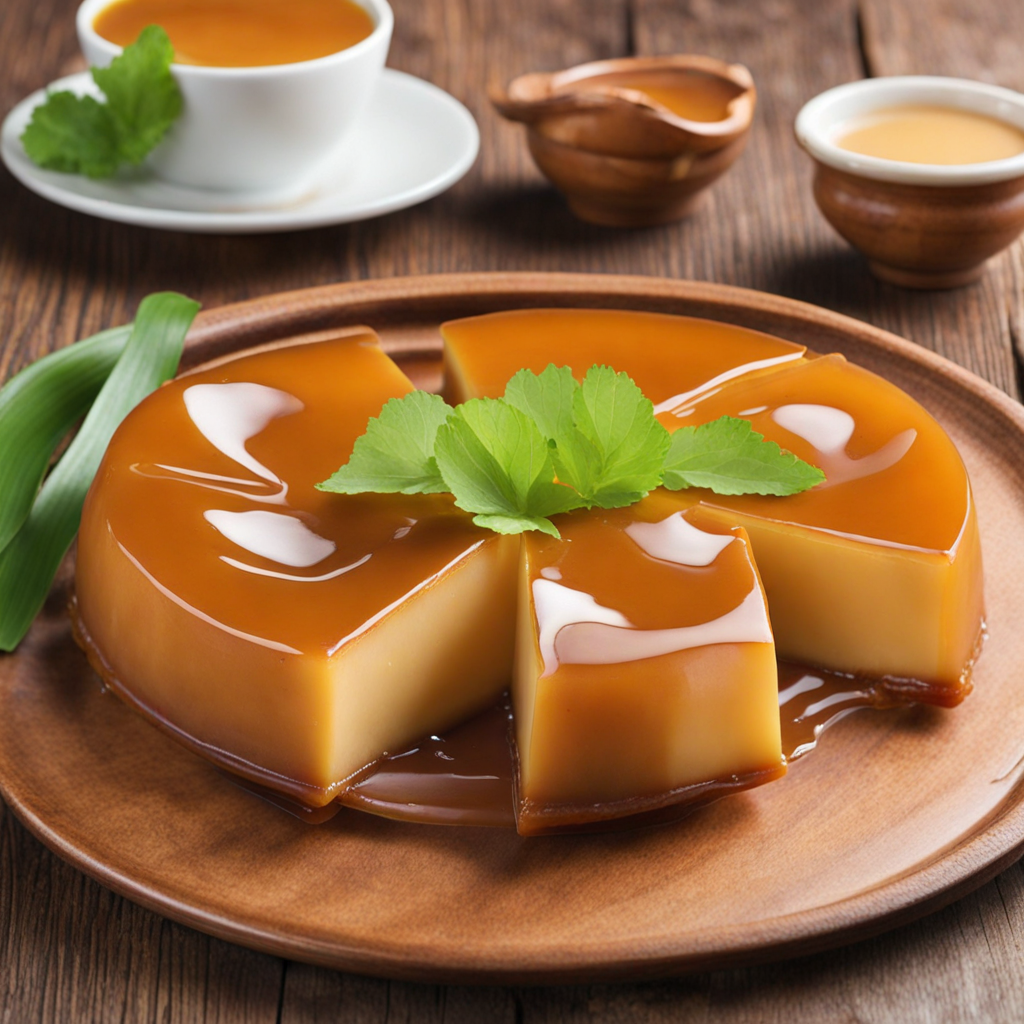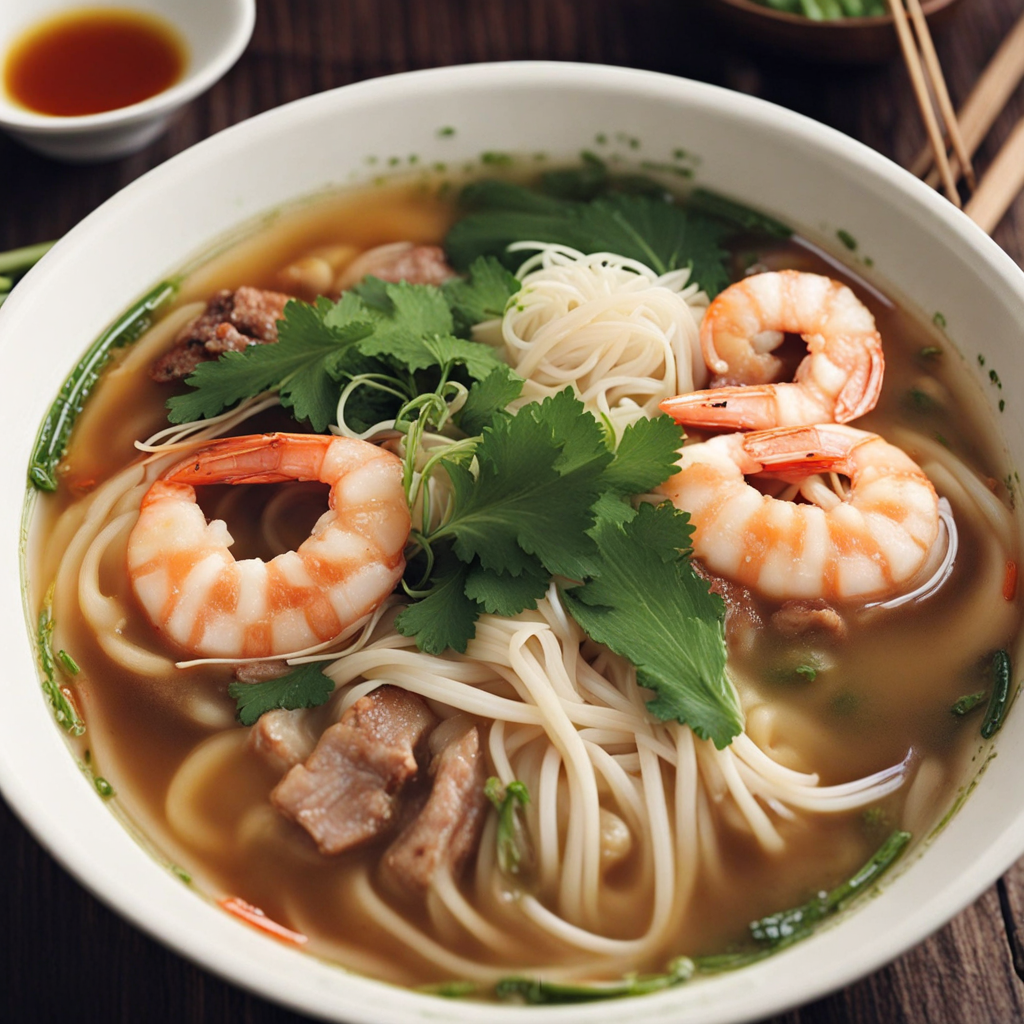Banh Tom
Banh Tom, a delightful Vietnamese dish, is a crispy shrimp cake that captures the essence of Vietnamese street food. This dish features a base of sweet potato and rice flour batter, which is often mixed with fresh herbs and seasonings to enhance its flavor. The batter is then combined with succulent shrimp, creating a perfect balance of texture and taste. When fried, the cakes develop a golden-brown crust that is both crunchy on the outside and tender on the inside, making each bite a satisfying experience. Typically served as a snack or appetizer, Banh Tom is often accompanied by a vibrant dipping sauce made from fish sauce, lime juice, sugar, and chili. This sauce not only adds a tangy contrast to the savory cakes but also elevates the overall flavor profile, making it a delightful treat for the palate. The dish is traditionally garnished with fresh herbs like lettuce and mint, which not only add a refreshing element but also enhance the dish’s visual appeal. As you explore Banh Tom, you'll discover the rich culinary traditions of Vietnam, where local ingredients and cooking techniques come together to create a unique taste sensation. The combination of crispy texture, succulent shrimp, and zesty dipping sauce makes Banh Tom a must-try for anyone seeking to indulge in authentic Vietnamese cuisine. Whether enjoyed on the bustling streets of Hanoi or in a cozy restaurant, Banh Tom promises a delightful culinary adventure that will leave you craving more.
How It Became This Dish
Bánh Tôm: A Culinary Gem of Vietnam Bánh Tôm, a delightful Vietnamese dish, is often celebrated for its crispy texture and rich flavors. This dish, which consists of shrimp fritters made from a mixture of mashed sweet potatoes and shrimp, is not just a culinary treat but also a reflection of Vietnam's rich cultural heritage. To truly appreciate Bánh Tôm, one must delve into its origins, cultural significance, and evolution throughout the years. #### Origins of Bánh Tôm The roots of Bánh Tôm can be traced back to the bustling streets of Hanoi in the northern region of Vietnam. The dish is believed to have originated in the late 19th to early 20th centuries, during a time when the French colonial presence in Vietnam began to influence local cuisine. The name "Bánh Tôm" translates to "shrimp cake," with "bánh" meaning cake or pastry, and "tôm" meaning shrimp. Bánh Tôm gained prominence in the Old Quarter of Hanoi, particularly in the area surrounding Hoàn Kiếm Lake. The dish was crafted by local street vendors who would prepare the fritters using fresh, locally-sourced ingredients. The use of sweet potatoes, which were abundant in the region, added a unique sweetness and texture to the fritters, setting them apart from other regional specialties. The shrimp, often caught from nearby rivers, provided a fresh seafood flavor that made the dish irresistible. #### Cultural Significance Bánh Tôm is more than just a snack; it is a symbol of Vietnamese culinary tradition and community. The dish is often enjoyed during family gatherings, celebrations, and festivals, serving as a reminder of the importance of sharing food and culture. In Vietnam, food is deeply intertwined with social rituals, and Bánh Tôm embodies this ethos. The act of gathering around a table, sharing stories, and savoring the crispy fritters fosters a sense of belonging and connection among family and friends. Moreover, Bánh Tôm reflects the Vietnamese philosophy of using fresh, seasonal ingredients. The dish is typically served with a side of dipping sauce made from fish sauce, lime juice, sugar, and chili, enhancing the flavors and creating a harmonious balance between sweetness, saltiness, and heat. This emphasis on balance is a hallmark of Vietnamese cuisine, showcasing the country's approach to cooking that prioritizes fresh, vibrant flavors. #### Development Over Time As Vietnam underwent significant socio-political changes throughout the 20th century, so too did its culinary landscape. The period following the Vietnam War saw a resurgence of interest in traditional dishes, including Bánh Tôm. As the country began to open its borders and embrace globalization in the 1990s, Bánh Tôm started to gain recognition beyond its geographical origins. In the 21st century, Bánh Tôm has transcended its humble street food roots and found its way into restaurants both within Vietnam and internationally. Chefs have begun to experiment with the traditional recipe, incorporating modern techniques and ingredients while still paying homage to its origins. For instance, some variations now include a mix of seafood, such as squid or crab, alongside the classic shrimp, while others opt for gluten-free alternatives by replacing the sweet potatoes with rice flour. Despite these innovations, the essence of Bánh Tôm remains intact. The dish continues to be a beloved favorite among locals and tourists alike, celebrated for its crispy texture and the delightful contrast of flavors. Street vendors still dominate the scene, often attracting long lines of eager customers, a testament to the enduring popularity of this culinary gem. In contemporary culinary discourse, Bánh Tôm has become emblematic of Vietnam's vibrant street food culture. Food bloggers and social media influencers have played a significant role in popularizing the dish, showcasing its visual appeal and deliciousness to a global audience. This newfound attention has not only elevated Bánh Tôm's status but has also encouraged a resurgence of interest in traditional Vietnamese cuisine as a whole. #### Regional Variations While Bánh Tôm is most closely associated with Hanoi, regional variations exist throughout Vietnam. In southern Vietnam, for example, a similar dish known as Bánh Xèo is popular. While Bánh Xèo is made from rice flour and filled with a variety of ingredients, including shrimp, pork, and bean sprouts, it shares the same spirit of being a communal dish that is enjoyed with family and friends. Additionally, in coastal areas, where seafood is abundant, you may encounter other fritter variations that highlight local ingredients. This adaptability is a hallmark of Vietnamese cuisine, where dishes evolve based on availability and regional tastes. #### Conclusion Bánh Tôm is not merely a dish; it is a representation of Vietnam's rich culinary history and cultural identity. From its origins in the streets of Hanoi to its current status as a global favorite, Bánh Tôm encapsulates the essence of Vietnamese food—fresh, flavorful, and communal. As the world continues to embrace diverse culinary traditions, Bánh Tôm stands as a testament to the enduring appeal of Vietnamese cuisine, reminding us of the importance of food in forging connections and preserving cultural heritage. Whether enjoyed at a bustling street stall or a fine dining restaurant, Bánh Tôm continues to captivate hearts and palates, making it a true gem of Vietnamese gastronomy.
You may like
Discover local flavors from Vietnam


